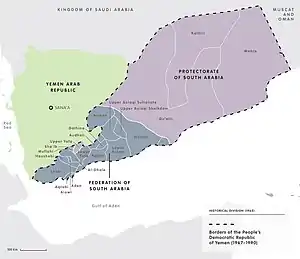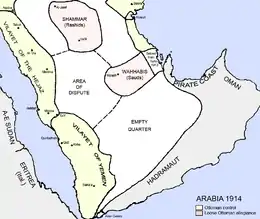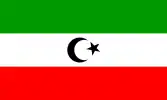Protectorate of South Arabia
The Protectorate of South Arabia consisted of various states located at the southern end of the Arabian Peninsula under treaties of protection with Britain. The area of the former protectorate became part of South Yemen after the Radfan uprising and is now part of the Republic of Yemen.
Protectorate of South Arabia محمية الجنوب العربي | |||||||||
|---|---|---|---|---|---|---|---|---|---|
| 1963–1967 | |||||||||
 Map of the Protectorate and the Federation of South Arabia. | |||||||||
| Status | British Protectorate | ||||||||
| Common languages | Arabic | ||||||||
| Historical era | Cold War | ||||||||
• Established | January 18 1963 | ||||||||
• Disestablished | November 30 1967 | ||||||||
| Currency | East African shilling, then South Arabian dinar (1965-67) | ||||||||
| |||||||||

History
Background
The background of the Protectorate of South Arabia is part of an effort of the British Empire to protect the East India Route, the sea route between the Mediterranean Sea and India, in and through the southern coasts of Arabia. Already before the opening of the Suez Canal, industrial Britain with its rapidly expanding economy, needed improved communication with British India.
The coastal plains of the peninsula had been devastated earlier in the 19th century by Wahhabi puritan Muslims from Central Arabia followed by an Egyptian invasion.[1] From the first commercial treaty with the Sultanate of Lahej in 1802, various efforts were made to avoid looting of East India ships, leading to the annexing of Aden by the East India Company in 1839. The Aden Protectorate was established in 1869, the same year of the opening of the Suez Canal which heralded a new era of trade and communication.[2]
20th century
The Protectorate of South Arabia was designated on 18 January 1963 as consisting of those areas of the Aden Protectorate that did not join the Federation of South Arabia, and it broadly, but not exactly, corresponded to the division of the Aden Protectorate which was called the Eastern Aden Protectorate.
The protectorate included the Hadhrami states of Kathiri, Mahra, and Qu'aiti except the three Wahidi Sultanates in the Eastern Aden Protectorate, with Upper Yafa in the Western Aden Protectorate. The Protectorate of South Arabia was dissolved on 30 November 1967 and its constituent states quickly collapsed, leading to the abolition of their monarchies. The territory was absorbed into the newly independent People's Republic of South Yemen, which became part of the Republic of Yemen in 1990.
States
| Flag | Name | Established | Joined | Notes |
|---|---|---|---|---|
 |
Mahra Sultanate | 15th century | 1886 | |
 |
Kathiri State | 14th century | 1888 | |
 |
Qu'aiti State | 1858 | 1888 | |
 |
Upper Yafa | circa 1800 | 1903 | Consisted of five Sheikhdoms: Al-Busi, Al-Dhubi, Al-Hadrami, Al-Muflihi, and Al-Mausata |
| Sheikhdom of al-Hawra | 19th century | 1890 | ||
| Sheikhdom of al-`Irqa | 19th century | 1890 | ||
| Sultanate of Tarim | Unknown | Unknown | Absorbed by Say'un (Kathiri) in 1945.[3][4] |
Former states of the British Aden Protectorate were united in the 1960s to form the People's Republic of South Yemen, which became independent on 30 November 1967. South Yemen later merged with North Yemen to form the modern state of Yemen in 1990.[5][6]
| State | Ruler | Deposed | House | Reign | Ref(s) |
|---|---|---|---|---|---|
| Salih ibn al-Husayn | 17 September 1967 | Al Audhali | Last reigning Sultan (1928–1967). | [6] | |
| Nasir ibn Aidrus | 29 November 1967 | Al Awlaqi | Last reigning Sultan (1947–1967). | [6] | |
| Awad ibn Salih | 29 November 1967 | Al Awlaqi | Last reigning Sultan (1935–1967). | [6] | |
| Saleh bin al-Husayn | 28 August 1967 | Al Habieli | Last reigning Emir (1935–1967). | [6] | |
| Shafaul ibn Ali Shaif | 17 August 1967 | Al Amiri | Last reigning Emir (1954–1967). | [6] | |
| Nasir bin Abdullah | 29 November 1967 | Al Fadhli | Last reigning Sultan (1964–1967). | [6] | |
| Faisal bin Surur | 29 November 1967 | Al Haushabi | Last reigning Sultan (1955–1967). | [6] | |
| Husayn ibn Ali | 2 October 1967 | Al Kathiri | Last reigning Sultan (1949–1967). | [6] | |
| Fadhl VI bin Ali | 17 August 1967 [as 1] | Al Abdali | Last reigning Sultan (1958–1967). | [6] | |
| Abdullah ibn Ashur | 16 October 1967 | Al Mahri | Last reigning Sultan (1966–1967). | [6] | |
| Ghalib II | 17 September 1967 | Al Qu'aiti | Last reigning Sultan (1966–1967). | [7][8] | |
| Ali ibn Muhammad | 17 August 1967[as 3] | Al Wahidi | Last governing Hakim (1967). | [6] | |
| Alawi ibn Salih | 29 November 1967[as 4] | Last reigning Sultan (1955–1967). | [6] | ||
| Husayn ibn Abdullah | 29 November 1967[as 5] | Last reigning Sultan (until 1967). | [6] | ||
| Mahmud ibn Aidrus | 28 August 1967[as 6] | Al Afifi[as 7] | Last reigning Sultan (1954–1967). | [6] | |
| Muhammad ibn Salih | 29 November 1967 | Harharah[as 7] | Last reigning Sultan (1948–1967). | [6] |
- Prior to his formal ascension to the throne, he had served as prince regent since 10 July 1958.[6]
- Known as Balhaf and Azzan from 1881, signifying Balhaf's merge with Wahidi Azzan. Known simply as Wahidi from 1962, when the sultanates of Wahidi Bir Ali and Wahidi Haban were made subordinate.[6]
- Prince Ali held the position of hakim (regent) from 20 February 1967 until the sultanate's abolition in August of the same year. He was never crowned sultan.[6]
- Alawi previously reigned as sultan from 1955 until the monarchy was abolished in 1967. Before his reign ended, he was made subordinate to the Sultan of Balhaf and Azzan on 23 October 1962.[6]
- Husayn had previously reigned as sultan prior to the monarchy's abolition in 1967. Before his reign ended, he was made subordinate to the Sultan of Balhaf and Azzan on 23 October 1962.[6]
- Mahmud previously reigned as sultan from 1954 until the monarchy was deposed in 1967. His reign was not initially recognised by the British government, which continued to recognise his still-living father and predecessor as sultan until 1958.[6]
- A clan of the Yafa tribe. The Yafai are divided into ten sheikhdoms that were spread across the former sultanates of Lower Yafa and Upper Yafa.[9]
See also
References
- Sarah Searight, The Charting of the Red Sea. History Today, 2003
- Frank Edwards, The Gaysh: A History Of The Aden Protectorate Levies 1927-61 And The Federal Regular Army Of South Arabia 1961-67
- "States of the Aden Protectorates". www.worldstatesmen.org. Retrieved 2019-06-26.
- "WHKMLA : History of Yemen". www.zum.de. Retrieved 2019-06-23.
- Montgomery-Massingberd, Hugh (1980). Burke's Royal Families of the World: Africa and the Middle East. London: Burke's Peerage. p. 320. ISBN 978-0-85011-029-6.
- Cahoon, Ben. "States of the Aden Protectorates". World Statesmen.org. Retrieved 27 April 2010.
- Soszynski, Henry. "Shihr and Mukalla". Genealogical Gleanings. University of Queensland. Archived from the original on 7 August 2009. Retrieved 20 April 2010.
- Kaaki, Lisa (4 May 2011). "The holy cities". Arab News. Saudi Research & Publishing Company. Archived from the original on 7 June 2011. Retrieved 28 May 2011.
- A Collection of First World War Military Handbooks of Arabia, 1913–1917. 3. Archive Editions. 1988. pp. 84–93. ISBN 978-1-85207-086-1.